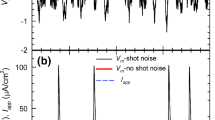Abstract
Flicker noise of electric currents through ion-selective membranes is explained. It is attributed to the depletion of salt on one side of the membrane, which creates a thin layer of high resistance. Joule heating in this depletion layer and the ensuing temperature gradient, as well as the concentration gradient, give rise to buoyant forces which may create a turbulent convection current. The turbulence mixes the depletion layer so that the electric resistance fluctuates, and consequently the current flickers.
Experiments with ion-selective membranes support this conjecture. They show that 1) Noise is coincident with the increase of the electric resistance by the depletion process. 2) When the current density is reduced, it reaches a critical value, below which the convection current changes from turbulent to laminar, and the noise disappears. 3) Noise reduces with temperature, because the expansion coefficient of water decreases with temperature, and its viscosity increases. 4) A non-ionic water-soluble polymer added to the compartment on the side of the depletion layer reduces the noise, by increasing the bulk viscosity of the solution. 5) Noise depends on the membrane's orientation in the gravitational field. 6) The convection-current in the depletion layer can be observed directly, using a laser-beam, by adding latex particles which create optical noise as they drift with the convection current across the beam. The optical noise is observed only coincidently with the current noise.
Similar content being viewed by others
References
Block, M., Kitchener, J. A.: Polarization phenomena in commercial ion-exchange membranes. J. Electrochem. Soc. 113, 947–953 (1966)
Calvin, W. H., Stevens, C. F.: Synaptic noise as a source of variability in the interval between action potentials. Science 155, 842–844 (1967)
Chandrasekhar, S.: Hydrodynamic and hydromagnetic stability. Oxford: Clarendon Press 1961
Conti, F., De Felice, L. J., Wanke, E.: Potassium and sodium ion current noise in the membrane of the squid giant axon. J. Physiol. (Lond.), 248, 45–82 (1975)
Conti, F., Wanke, E.: Channel noise in nerve membranes and lipid bilayers. Quart. Rev. Biophys. 8, 451–506 (1975)
Cooke, B. A.: Concentration polarization in electrodialysis — I. The electrometric measurement of interfacial concentration. Electrochim. Acta 3, 307–317 (1961)
De Felice, L. J., Michaelides, J. P. L. M.: Electrical noise from synthetic membranes. J. Mem. Biol. 9, 261–290 (1972)
Derksen, M. E., Verveen, A. A.: Fluctuations of resting neural membrane potential. Science 151, 1388–1389 (1966)
Dorset, D. L., Fishman, H. M.: Excess electrical noise during current flow through porous membranes separating ionic solutions. J. Mem. Biol. 21, 291–309 (1975)
Fishman, H. M.: Relaxation spectra of potassium channel noise from squid axon membranes. Proc. Nat. Acad. Sci. USA 70, 876–879 (1973)
Forgacs, C.: Deviations from the steady state in ion transfer through permselective membranes. Nature 190, 339–340 (1961)
Green, M. E.: Diffusion and 1/f noise. J. Mem. Biol. 28, 181–186 (1976)
Green, M. E., Yafusso, M.: A study of the noise generated during ion transport across membranes. J. Phys. Chem. 72, 4072–4078 (1968); (including erratum, ibid. 73, 1626 (1969)
Helfferich, F.: Ion exchange. New York: McGraw Hill 1962
Hooge, F. N.: Discussion of recent experiments on 1/f noise. Physica 60, 130–144 (1972)
Landau, L. D., Lifshitz, E. M.: Fluid mechanics. London: Pergamon Press 1961
Poussart, D. J. M.: Membrane current noise in lobster axon under voltage clamp. Biophys. J. 11, 211–234 (1971)
Siebenga, E., Meyer, A. W. A., Verveen, A. A.: Membrane shot-noise in electrically depolarized nodes of ranvier. Pflügers Arch. Ges. Physiol. 341, 87–96 (1973)
Stern, C. S. H., Green, M. E.: Noise generated during sodium and hydrogen ion transport across a cation exchange membranes. J. Phys. Chem. 77, 1567–1572 (1973)
Tchen, C. M.: Repeated-cascade theory of turbulence in an inhomogeneous plasma. Phys. Rev. A 8, 509–514 (1973)
Turner, J. S.: Buoyancy effects in fluids. London: Cambridge University Press 1973
Verveen, A. A., Derksen, H. E.: Fluctuation phenomena in nerve membrane. Proc. IEEE 56, 906–916 (1968)
Verveen, A. A., De Felice, L. J.: Membrane noise. Progr. Biophys. Molec. Biol. 28, 189–265 (1974)
Verveen, A. A., Derksen, M. E., Schick, K. L.: Voltage fluctuations of neural membrane. Nature 216, 588–589 (1967)
Vetter, K. J.: Electrochemical kinetics. New York: Academic Press 1967
Yafusso, M., Green, M. E.: Noise spectra associated with hydrochloric acid transport through some cation-exchange membrane. J. Phys. Chem. 75, 654–662 (1971)
Author information
Authors and Affiliations
Additional information
A. Katzir-Katchalsky Fellow
Rights and permissions
About this article
Cite this article
Lifson, S., Gavish, B. & Reich, S. Flicker noise of ion-selective membranes and turbulent convection in the depleted layer. Biophys. Struct. Mechanism 4, 53–65 (1978). https://doi.org/10.1007/BF00538840
Received:
Accepted:
Issue Date:
DOI: https://doi.org/10.1007/BF00538840




